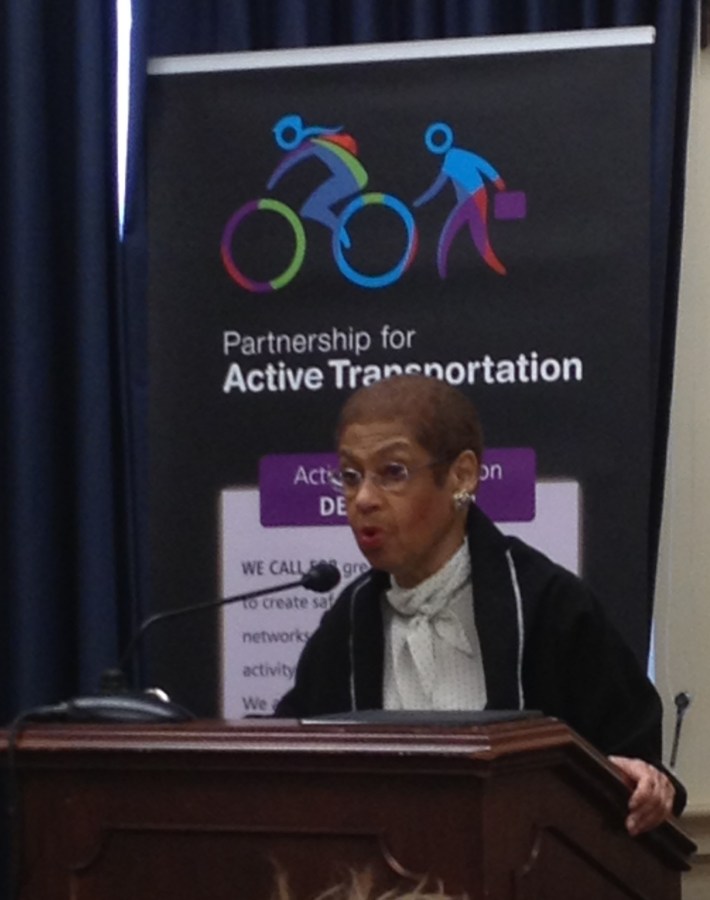The gospel of active transportation has spread. Thanks to a number of concurrent crises, from obesity to climate change to the "silver tsunami," it's become clear to more and more people that the simple act of walking and biking can have a major impact on averting some of the biggest problems America faces. So over the past several years, several different sectors have joined traditional biking and walking advocates in taking up the mantle of active transportation. And now those relationships have been consecrated into a new union: the Partnership for Active Transportation.

Some of the biking and walking groups you might expect to see in a coalition like this are notably absent, because the convening organization – the Rails-to-Trails Conservancy – didn't want to fill it up with the usual suspects. Instead, they brought in organizations that aren’t obvious allies: the American Public Health Association, the American Academy of Pediatrics, and the LOCUS project of Smart Growth America that represents real estate developers. AARP is a key player in the new partnership too, though they haven’t quite said “I do,” yet.
“We’ve been making the public health argument for years,” said RTC president Keith Laughlin, “but we are bike advocates. We don’t have the right initials after our names.”
That’s where this partnership comes in. All the groups involved will more or less keep doing the same work they’ve always been doing, but now they can show the formal participation of people “who have all the right credentials” and can make a compelling argument from the point of view of the health or real estate sector that walking and biking are critical components of the transportation system. Showing lawmakers that active transportation has support from these sectors could help broaden the base of support for these programs on Capitol Hill.
The groups launched the partnership this morning on Capitol Hill, in one of the House office buildings, under the banner “Safe Routes to Everywhere,” a spin on Safe Routes to School. Rep. Tom Petri (R-WI), a longtime bike advocate and chair of the Subcommittee on Highways and Transit, and Del. Eleanor Holmes Norton (D-DC) made some opening remarks cheering on the group. Rep. Dan Lipinski (D-IL) stopped by later and gave his congratulations.
Susan Polan, there representing the American Public Health Association, acknowledged that it’s unusual for her group to sit down with real estate developers and agree on anything. “It’s a strange bedfellows coalition,” she said, “and that’s one of the reasons why it works.” She said this year is “the year of health,” with the rolling out of the health reform law, and that supporting communities to walk and bike more fits right in with that mandate.
The message the partnership will take to Capitol Hill has three parts:
- Double bike/ped’s share of federal funding from 1.5 percent in MAP-21, the current transportation bill, to 3 percent. “That would still be miniscule compared to what we invest in highways but it would be truly transformative in terms of what happens in communities on the ground and the choices we give people about how we get around,” said RTC’s Kevin Mills. Doubling the proportion of funding dedicated to biking and walking would reduce highways’ share of the total from 77.5 percent to 76 percent.
- Prioritize the creation of biking and walking networks. “All transportation modes work best when they’re knitted together into a system,” said Mills. They’d like to see a portion of the bike/ped funds to go to filling in the gaps in networks. The groups want to create an Active Transportation Networks Investment Fund to concentrate on these areas. Under this policy plank, they also call for the enactment of a federal complete streets policy.
- Reform the Transportation Alternatives Program to stop states and jurisdictions from “flexing” money toward other uses or “opting out” of the Recreational Trails Program.
More than a quarter of all trips made in this country are less than a mile long, and nearly half are less than three miles – yet Americans make more than 78 percent of these short trips by car. Convenient, safe, and appealing bicycle and pedestrian facilities would help more people make a fundamental shift in their daily habits, reducing air pollution and improving their own health in the process.





